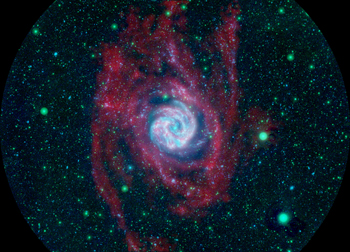 |
CHAMÄLEON + ONJALA OBSERVATORY DeepSky | SITEMAP HOME CHAMÄLEON |
|
 |
|||
| « zurück zur Startseite
Galaxien « back to home galaxies |
Großes Bild laden - load large image 2048 x
1400 Pixel Aufnahmedaten Image data |
Messier 83 - the southern "Southern Pinwheel Galaxy" in the constellation Hydra

Messier 83 - unser Bild zeigt in hoher Auflösung eine der wohl schönsten "face on - grand design" Spiralgalaxien des Himmels. Messier 83 ist die Zentralgalaxie der so genannten M 83 Galaxiengruppe und liegt benachbart zur lokalen Gruppe. Sie erstreckt sich über die Sternbilder Wasserschlange (Hydra), Zentaur (Centaurus) und den Südteil der Jungfrau (Virgo). Sie ist Teil einer zweiten, größeren Galaxiengruppe, deren Zentralgalaxie NGC 5128 - Centaurus A - eine große "Starburst-Galaxie" und eine der stärksten Radioquellen am Himmel ist. Die beiden Gruppen stehen sich physisch nahe und scheinen sich relativ nicht zueinander zu bewegen, weshalb sie auch oft als eine einzige, größere Galaxiengruppe betrachtet wird.
Messier 83 steht in einer Entfernung von etwa 15 Millionen Lichtjahren zum Sonnensystem im Sternbild Hydra (Wasserschlange). Mit rund 50.000 Lichtjahren Durchmesser ist sie nur halb so groß wie die Milchstraße, unserer Galaxie ansonsten aber sehr ähnlich. Sie hat eine deutlich sichtbare Spiralstruktur mit ausgeprägten H-II Regionen und vielen offenen Sternhaufen und einen zentralen Balken aus alten Sternen und wird als so genannte Zwischenspirale - zwischen normaler Spiralgalaxie und Balkenspirale - klassifiziert. M 83 war die erste Galaxie, die außerhalb der Lokalen Gruppe im Jahr 1751 von Nicolas Louis de Lacaille entdeckt wurde.
Object description
Messier 83 - our image shows in high resolution one of the most beautiful "face on - grand design" spiral galaxies of the sky. Messier 83 is the central galaxy of the so called M 83 galaxy group and lies adjacent to the local group. It spans the constellations of Water Serpent (Hydra), Centaur (Centaurus), and the southern part of Virgo (Virgo). It is part of a second, larger galaxy group whose central galaxy, NGC 5128 - Centaurus A - is a large "starburst galaxy" and one of the most powerful radio sources in the sky. The two groups are physically close and do not appear to move relative to each other, which is why it is often considered a single, larger galaxy group.
Messier 83 stands at a distance of about 15 million light-years from the solar system in the constellation Hydra (Water Snake). With a diameter of about 50,000 light-years it is only half the size of the Milky Way, but otherwise very similar to our galaxy. It has a clearly visible spiral structure with distinct H-II regions and many open star clusters and a central bar of old stars and is classified as a so-called intermediate spiral - between normal spiral galaxy and barred spiral. M 83 was the first galaxy discovered outside the Local Group in 1751 by Nicolas Louis de Lacaille.
 |
Besonders interessant zeigt sich Messier 83 im Radiobereich. Das Bild
zeigt ein Komposit aus UV Licht und der Radioemission der 21cm
Wellenlänge. Es wurde im Jahr 2008 vom NASA Satelliten Galaxy Evolution
Explorer und dem Very Large Array in New Mexico aufgenommen. Gasförmige
Wasserstoffatome sind rot, fernes Ultraviolett blau und nahes UV in grün
codiert. « Klicken Sie hier oder auf das Vorschaubild zum Laden eines großen. Quelle: NASA/JPL-Caltech/VLA/MPIA, gemeinfrei. Weitere Informationen hier. Messier 83 is particularly interesting in the radio region. The image shows a composite of UV light and the radio emission of the 21cm wavelength. It was taken in 2008 by NASA's Galaxy Evolution Explorer satellite and the Very Large Array in New Mexico. Gaseous hydrogen atoms are coded in red, far ultraviolet in blue, and near UV in green. « Click here or on the thumbnail to load a large image. Image source: NASA/JPL-Caltech/VLA/MPIA, public domain. More information here. |
Messier 83 - the southern "Southern Pinwheel Galaxy" in the constellation Hydra
Image data
Date: some nights in june 2022 - 45 x 600 s, QHY ALccd 12 (cooled)
Telescope: CDK 12.5" PlaneWave Astrograph + 0.8x Reducer at f = 2030 mmm
Location: Chamäleon Observatory, Onjala Lodge, Namibia
Image acquisition and processing: DeepSkyStacker, PixInsight + Photoshop by Bernd Gooßmann
 |
 |
 |
 |
 |
 |
 |
| Sonne | Mond | Sonnensystem | DeepSky | Weitwinkel | Verschiedenes | Spez. Projekte |